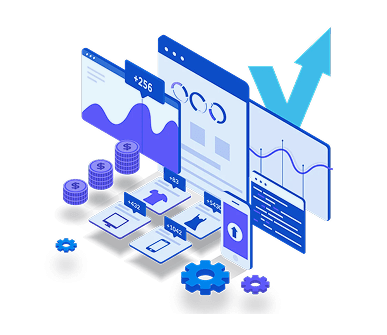
So, you have started your search for a price monitoring tool. That’s a smart move, honestly.
You might have already realized how it feels to keep track of the prices manually. It’s not just consuming, but also frustrating. And, staying competitive would be a hardcore job.
Let’s say your competitor drops their price today. How quickly would you catch it? Probably, by the time you identify it, they would have snatched your sale already.
On the other side, there is a price war happening among your resellers. That could deeply erode your brand integrity and customer trust.
The end result in both the cases? Leaked revenue.
→ Try DigiSense360 for Free NowWe can’t deny the fact that price is one of the key factors that determines the purchase decision. Even a slight variation could make or break your sale. Shoppers constantly compare the prices and always look for the best possible deal they can get.
That’s why what you thought is right. A reliable price monitoring tool could automate the entire process, giving you accurate and real-time data without the headache. Whether you are selling a single product on Amazon or hundreds of products on multiple marketplaces, the right tool could give you the edge.
You might have a lot of questions in your mind, what exactly a price monitoring tool does, how it works, how much does it cost, and most importantly, is it worth the investment.
In this blog, you’ll get answers to all your questions. Let’s begin from the scratch.

Stay Ahead with Smarter Price Monitoring
What Is a Price Monitoring Tool?
A Price monitoring tool is a software used to automatically track and analyze the product prices in real-time. It could be your own product pricing, competitor prices, or MAP compliance by resellers.
It gathers data from multiple sources, such as competitor websites, ecommerce marketplaces, and any other sales channels to gain insights on pricing and market trends. With this, businesses can adjust their pricing strategically to stay competitive and maximize profits without any guesswork.
Who needs it?
Price monitoring tools are not just meant for Pricing teams, it offers value across multiple functions of a business.
eCommerce Managers
With real-time market intelligence, eCommerce managers could dynamically adjust their strategies to improve visibility, buy box wins, and optimize revenue across marketplaces.
Brand Managers
Price monitoring tools help brand managers track MAP violations among resellers across the marketplaces. It enables them to prevent the brand reputation, integrity, and most importantly customer trust.
Pricing Managers
With real-time competitor data and historical price trend data, pricing managers can craft better pricing strategies. It helps them protect profit margins and make data-driven pricing decisions.
Inventory Managers
With historical market trend data, inventory managers can forecast the demand more accurately, avoiding any shortage or excess stocking. After all, guessing is very much risky in inventory planning.
Marketing Teams
Marketing teams could analyze the competitor price patterns and strategically plan promotions and discounts at the optimal time. It ensures every campaign delivers the desired results.
Benefits of Using Price Monitoring Tools
A Price Monitoring tool could bring in a lot of benefits that can transform how you manage pricing. Here are some of the key benefits:
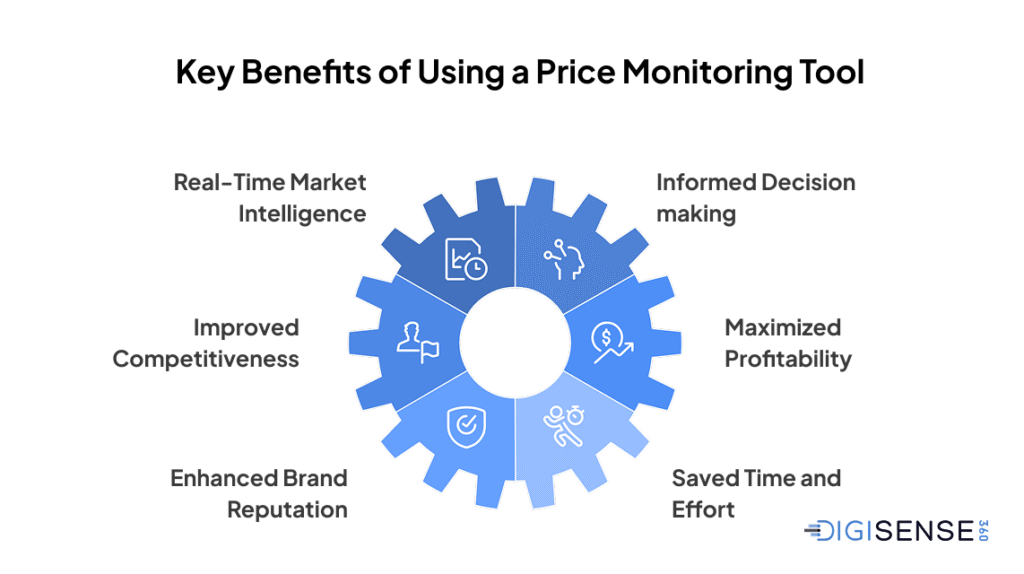
Real-Time Market Intelligence
Real-time price tracking helps gain a better understanding of competitor pricing and market trends, enabling you to fine-tune your pricing strategies accordingly. Always stay ahead of changes in this dynamic market.
Informed Decision making
With access to accurate and up-to-date data, you could easily move forward and make more confident data-backed decisions. Let it be pricing, planning promotions, or managing inventory, no more guesswork.
Improved Competitiveness
By keeping an eye on competitor prices, you can anticipate market moves and align your prices with demand. Simply said, you can be proactive and not reactive. This means better positioning, more buy box wins, and increased market share.
Maximized Profitability
With data-driven insights, you’ll be able to set optimal prices, balancing both sales volume and profit margin. This approach eventually leads to increased revenue and growth, without sacrificing profits.
Enhanced Brand Reputation
Monitoring resellers enables you to quickly spot and address unauthorized sellers violating the MAP policy. And, consistent pricing strengthens your brand image and enhances customer perception.
Saved Time and Effort
Price monitoring tool reduces the need for manual data collection and analysis (which drains hours), freeing up more time. You could allocate that time more efficiently to strategic tasks that actually drive growth.
Key Features to Look For
Depending on the type of software, the set of features offered might vary. But here are certain must-have features that you can’t neglect in a price monitoring tool.
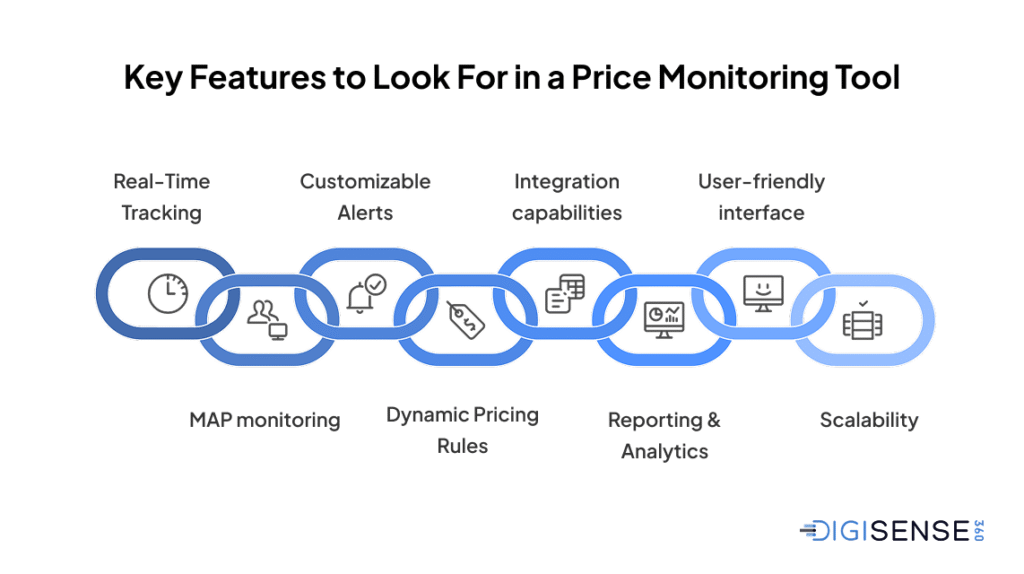
Real-Time Tracking
A price monitoring tool should automate the entire process of price tracking, and give real-time updates on competitor pricing without any manual intervention. This way, you can make proactive decisions without missing anything. No lag, no missed opportunities.
MAP monitoring
For brands, tracking seller compliance is crucial. Your tool should be able to spot the MAP violations quickly, helping you protect your brand integrity.
Customizable Alerts
You should be able to set and receive alerts when competitor change their prices or a reseller drops below the minimum level. Catch it the moment they happen. So your team can respond immediately to the price fluctuations or policy breaches.
Dynamic Pricing Rules
Advanced price monitoring tools allow you to automate pricing adjustments based on competitor behavior, inventory level, or any preset rules. Trust me, it could save you a lot of time and effort.
Integration capabilities
It should seamlessly integrate with your existing tech stack, including ERP, CRM, Inventory Management systems, or any eCommerce platforms, to ensure a smooth data flow. You should be able to get the full potential of the tool without disrupting your existing operations.
Reporting & Analytics
Should offer intuitive dashboards, customizable reports to monitor key metrics and KPIs relevant to your business. Some tools even provide AI-powered chatbots that let you easily extract the key insights by just conversing, which is a plus for sure.
User-friendly interface
Your team should be able to easily navigate and understand the tool, with a minimal learning curve. After all, what is the point of having a tool with bad UI that takes away hours?
Scalability
Your tool should scale along with your business, accommodating the growing number of competitors and products. It should also support tracking prices in multiple currencies if you plan to expand globally.

Stay Ahead with Smarter Price Monitoring
Top Price Monitoring Tools to Consider
As not all the tools are created equal, the best price monitoring tool depends on your specific needs and use case. Here are some of the widely recognized options:
DigiSense360
DigiSense360 provides AI-powered Digital Shelf Analytics, including real-time competitor price monitoring, MAP monitoring, customizable alerts, product rank tracking, customer review analysis, and channel specific content audit and generation.
Prisync
Prisync provides a comprehensive solution for all pricing needs, including competitor price tracking, MAP monitoring, Dynamic pricing, instant alerts, and also digital shelf management.
Price2Spy
Price2Spy provides a range of features that help brands and retailers, including real-time price monitoring, MAP monitoring, alerting, dynamic repricing and comprehensive reporting.
IntelligenceNode
IntelligenceNode provides competitive intelligence, including competitor price monitoring, dynamic pricing, MAP monitoring, content optimization, share of search tracking, assortment planning, and competitive benchmarking.
Dealavo
Dealavo provides numerous features meant for eCommerce professionals, including price monitoring, price automation, dynamic pricing, promotion tracking, assortment analysis and reporting.

Stay Ahead with Smarter Price Monitoring
How to Choose the Right Tool
As we’ve already said, there isn’t a one-size-fits-all solution available. Follow this step-by-step process to choose the right tool for your business:
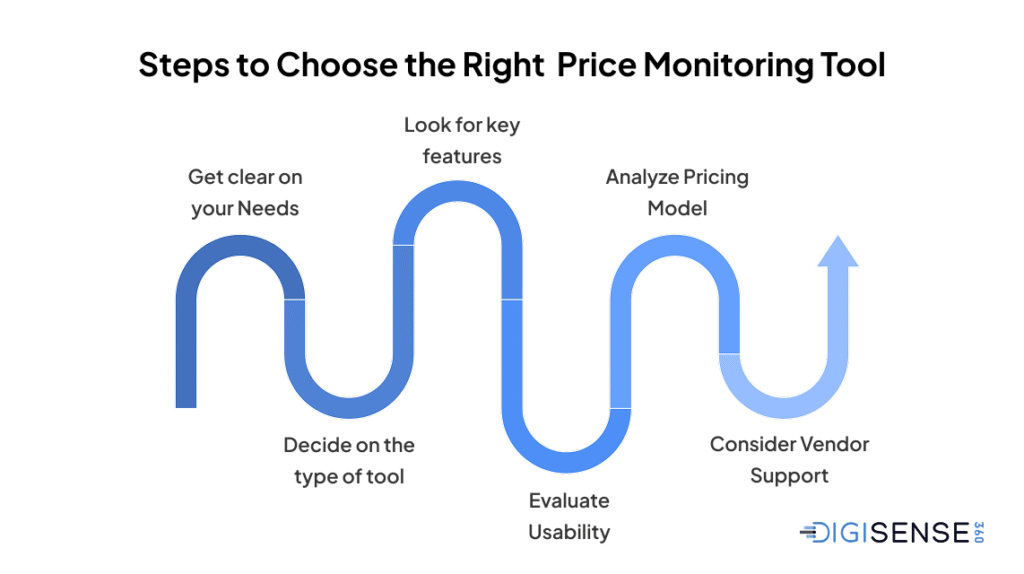
Get clear on your Needs
Start by identifying your specific business needs. What do you expect from a price monitoring tool? Maintaining competitive pricing, MAP enforcement, or pricing automation, list them down. A clear understanding of your goals will make the rest of the process easier.
Decide on the type of tool
Based on your goals, determine the type of tool you need for price monitoring. Whether it’s a basic price tracking tool, dynamic pricing software, digital shelf analytics software, or a comprehensive pricing suite. Your choice should depend on your business size, industry, and required features.
Look for key features
After deciding the type of tool, check if it has the key features we discussed above. Also make a list of features that you need other than the must-haves and look for them. But, don’t get distracted by the features that you don’t even use. Just look out for the ones that actually add value to your business.
Evaluate Usability
Just because a tool has a wide range of features doesn’t mean it’s the best. The core is usability. If the tool lacks a decent UI and your team can’t use it efficiently, then everything is lost. Utilize the free trials offered, and check if it is easy to use and navigate without any complexity.
Analyze Pricing Model
Each tool in the market offers different pricing models. It could be either fixed, tiered, or usage based. Some even have customized plans, which is usually based on the features you opt for. Analyze it carefully and check if it fits within your budget. Don’t forget to check if there are any hidden costs.
Consider Vendor Support
Though price monitoring tools are not so complex, assessing the quality of customer support is necessary. Check if they provide onboarding assistance, training resources, and any ongoing help if needed.
Measuring the ROI
To justify the investment in a price monitoring tool, track these key metrics:
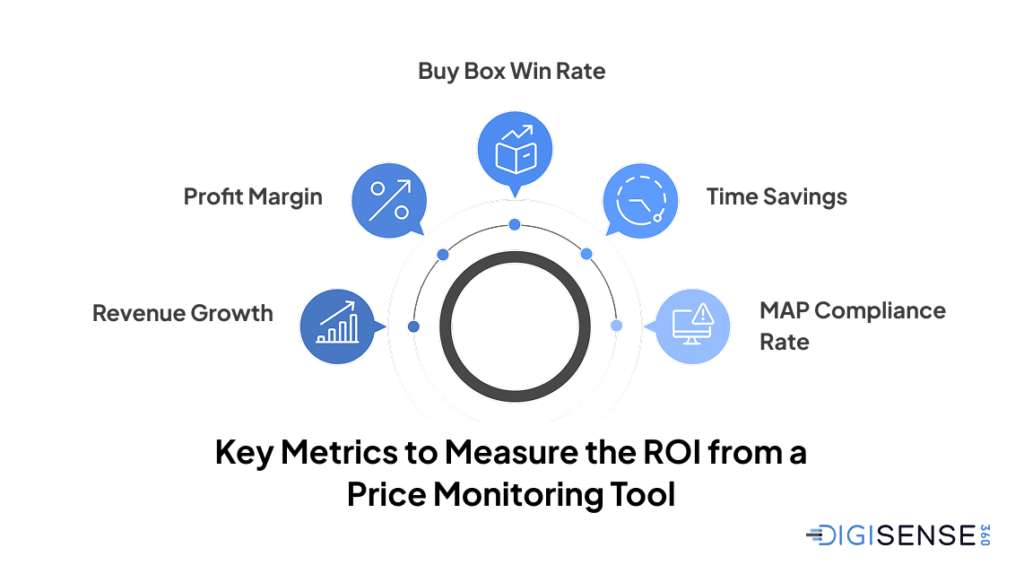
Revenue Growth
Is your revenue going up? Look for changes in sales volume and revenue before and after adopting a price monitoring tool, to see its impact on overall income.
Profit Margin
Has your profit margin improved by eliminating unnecessary discounts and price cuts? Measure the lift in profit margin percentage after implementing the price monitoring tool. If you want to be more specific, check this on SKU level.
Buy Box Win Rate
Are you getting more Buy Box wins? If you are an eCommerce seller, track the percentage increase in buy box share on marketplaces as a result of competitive pricing.
Time Savings
How much manual effort is reduced by automating price tracking and alerts? Record and compare the time spent on price monitoring before and after implementing the tool. To quantify that, multiply the saved hours by the hourly labor cost.
MAP Compliance Rate
Have the reseller price violations reduced? If you are a brand, track the number of MAP violations detected and resolved before and after, calculating the percentage decrease.

Stay Ahead with Smarter Price Monitoring
Final Thoughts
Staying competitive has become more important than ever. With intense competition and frequent price changes, relying on manual price monitoring is not wise. You could end up losing sales, profits, and market share before you even realize it.
Investing in a price monitoring tool helps you stay ahead always by enabling data-driven decision making. It allows you to spot the market trends quickly, get real-time updates on price changes, protect your margin, and optimize your pricing strategies. Also, it saves you a tremendous amount of time and effort by automating the entire process. No manual work, no missed opportunities.
But remember, the key is to choose a tool that aligns well with your specific business needs and budget. Feel free to start your research by exploring DigiSense360.
Why DigiSense360?
DigiSense360 is designed to help eCommerce businesses get all the insights they need to stay competitive. You can track competitor pricing, monitor product rankings, manage stock, analyze reviews, and generate AI-powered A+ content: All in one place.
If you’re wondering whether it fits your budget, you can take a look at our pricing.
FAQs
Price tracking tool is software that automatically tracks and analyzes product prices in real time, helping you make smarter, data-driven pricing decisions.
Dynamic pricing software is a tool that can be used by online retailers to automatically adjust the prices of their products in real-time. It could be based on time, market demand, inventory levels, customer behavior, competitor moves, or any preset rules.
There isn’t a single ‘best price monitoring tool’ for everyone. Instead look for the right tool, the one that fits your business needs, budget, and goals.
The cost of a price monitoring tool usually depends on the number of products and marketplaces tracked, and the frequency of data collection.

Stay Ahead with Smarter Price Monitoring

![Dynamic Pricing Software [The Ultimate Guide] Dynamic pricing software](https://www.pimworks.io/blog/wp-content/uploads/2025/08/Dynamic-pricing-software-370x245.png)

